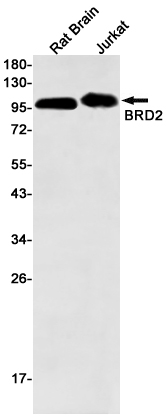
| WB | 咨询技术 | Human,Mouse,Rat |
| IF | 咨询技术 | Human,Mouse,Rat |
| IHC | 咨询技术 | Human,Mouse,Rat |
| ICC | 技术咨询 | Human,Mouse,Rat |
| FCM | 咨询技术 | Human,Mouse,Rat |
| Elisa | 咨询技术 | Human,Mouse,Rat |
| Aliases | Brd2; FSH; FSRG1; NAT; O27.1.; RING3; RNF3 |
| Entrez GeneID | 6046 |
| WB Predicted band size | Calculated MW: 88 kDa; Observed MW: 110 kDa |
| Host/Isotype | Rabbit IgG |
| Antibody Type | Primary antibody |
| Storage | Store at 4°C short term. Aliquot and store at -20°C long term. Avoid freeze/thaw cycles. |
| Species Reactivity | Human,Rat |
| Immunogen | A synthetic peptide of human BRD2 |
| Formulation | Purified antibody in TBS with 0.05% sodium azide,0.05%BSA and 50% glycerol. |
+ +
以下是关于BRD2抗体的3篇代表性文献及其摘要的简要总结:
---
1. **文献名称**: *Selective inhibition of tumor oncogenes by disruption of super-enhancers*
**作者**: Lovén, J. et al.
**摘要**: 该研究利用BRD2抗体通过ChIP-seq技术鉴定了癌症细胞中BRD2蛋白在超级增强子区域的富集,揭示了BRD2通过调控致癌基因(如MYC)的表观遗传机制促进肿瘤生长的作用。
---
2. **文献名称**: *BET bromodomain inhibition as a therapeutic strategy to target c-Myc*
**作者**: Delmore, J.E. et al.
**摘要**: 研究使用BRD2抗体进行免疫共沉淀实验,证明BRD2与c-Myc启动子区结合,并通过抑制BET蛋白功能阻断了多发性骨髓瘤细胞的增殖,为靶向BRD2的癌症治疗提供了依据。
---
3. **文献名称**: *Brd2 is required for neural stem cell differentiation in the adult brain*
**作者**: Shang, E. et al.
**摘要**: 通过BRD2抗体的免疫组化分析,发现BRD2在小鼠成体神经干细胞分化过程中调控关键神经基因的表达,敲除BRD2导致神经元发育异常,提示其在神经系统疾病中的潜在作用。
---
4. **文献名称**: *BRD2 regulates pancreatic β cell mass and insulin secretion*
**作者**: Wang, F. et al.
**摘要**: 利用BRD2特异性抗体进行Western blot和免疫荧光实验,揭示BRD2通过调控细胞周期蛋白表达影响胰岛β细胞增殖,并参与糖尿病相关的代谢调控通路。
---
以上文献中,BRD2抗体主要用于蛋白定位、功能验证及机制研究,涵盖癌症、神经发育和代谢疾病等领域。
The BRD2 antibody is a crucial tool for studying the bromodomain-containing protein 2 (BRD2), a member of the Bromodomain and Extra-Terminal (BET) family. BRD2 contains two tandem bromodomains (BD1 and BD2) that recognize acetylated lysine residues on histones, enabling its role in epigenetic regulation of gene expression. It binds to acetylated chromatin, facilitating transcriptional activation or repression of target genes involved in cell cycle progression, inflammation, and oncogenesis. BRD2 is implicated in diseases such as cancer, autoimmune disorders, and neurological conditions, making it a therapeutic target.
BRD2 antibodies are widely used in techniques like chromatin immunoprecipitation (ChIP), Western blotting, immunofluorescence, and flow cytometry to detect BRD2 expression, localization, and interactions. They help elucidate BRD2’s role in transcriptional networks, including MYC and NF-κB pathways, and in mediating responses to BET inhibitors (e.g., JQ1). Commercial BRD2 antibodies vary in specificity, with some distinguishing BRD2 from homologous BET proteins (BRD3. BRD4. BRDT). Validation across applications and species (human, mouse, rat) is critical, as cross-reactivity or batch variability may affect results. Researchers often verify antibody performance using knockout controls or epitope tagging. As BRD2-targeted therapies advance, these antibodies remain essential for mechanistic studies and drug development.
×